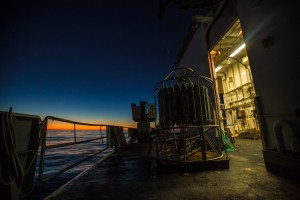If it has not yet been made obvious, work at sea is around the clock. Depending on which sites you want to collect samples from, what time we deploy the CTD or multicore, and how long it takes to process your samples, you will either be sleeping enough or barely at all. The past few days, I’ve certainly fallen into the latter category (especially since I’ve rotated through as chief scientist from midnight-noon in addition to sampling).
Although I’m pretty exhausted, there is something in the air on a ship that motivates me to keep going. It’s similar for everyone, I’d imagine. There is this feeling of “wow, this ship is out here for me to do my work, and I only have a few days to do it, so I should make the most out of it”. You also hit a kind of adrenaline high when the CTD/multicore comes on board and there is a mad rush to start collecting samples. Also, chances are very good that you are not the only one awake at any given time. The galley is always open with snacks and things to keep you occupied. It’s also great to stand out on deck and look at the stars, or try to spot wildlife (myself and the core team watched a pod of dolphins chase the chip ~3AM today).
So, inevitably, you end up awake at 5AM, having only taken a short nap since the night before. Yet there are samples to be processed, time points to take, and a new CTD going into the water in an hour.
How do you survive and not end up fast asleep at your bench?
Here are a few things that get me through the night:
- Spontaneous dance parties (admittedly not so spontaneous; they are most effective when they last the length of your sample processing time, and are better with friends; note that you need a good playlist or four)
- Laughter (see above; you and/or your friends are most likely not very good at dancing)
- ‘MidRats’ (mid-night rations; snacks and leftovers from previous meals in the galley that are ripe for the picking; tonight, mac & cheese hit the spot)
- ‘Fat Kid’ Coffee (1 packet of hot cocoa, mixed into coffee with cream and sugar; whipped cream optional but recommended; the right mix of caffeine and sugar with a touch of childhood nostalgia)
- Constant movement (walking across the ship to freeze samples or put them in an incubator makes this easy; otherwise, you don’t really need an extra excuse to go outside and look at the moon and stars)
- Companions (it is much easier to stay awake when someone else is fighting off sleep at the same time – you can keep each other focused and encourage any of the above)
- Data (yes, it will take months to process and write up results, but day-dreaming – night dreaming? But like, not when you’re actually asleep – of a future publication helps keep me going).
- Cold (personally, I fall asleep when I’m too warm, so cold air helps keep me awake. It also helps that the Hydro Lab feels like Antarctica, though my companions may disagree that this is a positive aspect)
Hopefully that provides a little insight as to why we oceanographers don’t dread working into the night. It isn’t always fun, but you never want to leave a cruise feeling like you didn’t sample enough. As I mentioned before, chances are good that you won’t be the only one awake at 4AM, and the delirium of sleep deprivation lends itself to great conversations and lots of laughter as you commiserate your long hours together. Plus, inevitably the cruise will end and you can sleep for real when you get back home.
Posted by Bradley Tolar

